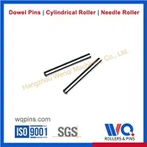Positioning pin
Welcome back to our “What the Hell Is It” series where we discuss some of the unique fasteners and electronic hardware that manufacturers use when designing and assembling their products. Today, we will introduce you to pins.
What is a positioning pin?
If you've ever shopped at IKEA or assembled your own furniture, you'll be familiar with the nail-shaped, unthreaded wooden dowels, also known as dowels, used to join pieces together.
For manufacturing purposes, dowel pins are solid headless cylindrical straight metal pins with a centerless finish. Dowel pins are typically hardened and manufactured to exact fractional diameters and lengths, and come in a variety of sizes, styles, designs, and materials, which can cause confusion for buyers, engineers, and end-users! Today we will try to simplify this confusing category of fasteners.
Who uses dowels?
Dowel pins are used as hinges, axles, or pivots to position or secure parts together in precision assemblies or fixtures.
They are widely used in a variety of applications across many industries, including: aerospace, electrical, hydraulic equipment, instrumentation, tools and fixtures, machinery, military, and more.
Dowel pins are popular in assemblies because they can withstand frequent insertion and removal without deformation. Production favors pins because they require no additional fastening hardware to insert, no secondary operations, and no mating parts. It all adds up to faster production and makes everyone in the food chain happy!
What should you consider when choosing a dowel?
Although dowel pins are available in a variety of materials and styles, there are some major issues to consider when it comes to major commercial and military spec products.
Standard, Extra Large or Small?
Standard series locating pins are used for initial applications. Their base diameter is 0.0002 inches above the nominal diameter. For example, a 1/4 standard pin has a diameter between 0.2501-0.2503.
Oversized series dowel pins are commonly used to fit into worn holes and are often used for aftermarket repairs. Their base diameter is 0.001 inch above the nominal diameter. For example, a 1/4 oversize pin has a diameter between 0.2509-0.2511.
Undersized series dowel pins are used in inconsistent holes. Their base diameter is -0.0002 inches below the nominal diameter. For example, a 1/4 size smaller pin has a diameter between 0.2500-0.2498. Mil-P-21143/2- Belongs to the small category.
Are the ends chamfered or radiused?
Generally, commercial pins are manufactured to the British standard ANSI ASME B18.8.2. Standard alloy pins have a radius on one end and a chamfer on the other. However, stainless steel dowels usually have chamfers on both ends.
Commercial or military?
If you or your customers require domestic DFAR pins that meet the strictest standards, then military pins may be the option for you!
Alloy or stainless steel? So what kind of stainless steel?
Alloy steel is the strongest pin available and is hardened. It can be surface treated with black oxide to provide better rust protection than regular alloys.
Type 416 stainless steel is the strongest standard stainless steel product and is the material used in the MS16555 and MS16556 series. Magnetic.
Type 18-8/303 stainless steel is the most commonly used stainless steel and is the standard material in the Mil-P-21143 series.
Type 316 stainless steel is the most corrosion-resistant stainless steel and is not associated with military-spec parts.
Are there other factors to consider?
Dowel pins often appear under their military spec numbers, which can be crossed with commercial equivalents. Some common mil-spec dowel pin series include Mil-P-21143 (303 stainless steel), MS16555 (standard series available in alloy and 416 stainless steel), and MS16556 (extra-large series available in alloy and 416 stainless steel).
If you do not order by MS or NAS Mil-Spec part number, imperial dowel pins comply with ANSI/ASME B18.8.2. For commercial pins, be careful to specify the material and size tolerances you require. Unless otherwise noted, dowel pins are precision ground, hardened, and heat treated to the appropriate Rockwell hardness.
Remember, don't use a hammer! When installing dowels, never force the dowel into the hole, always press it in for best results.





